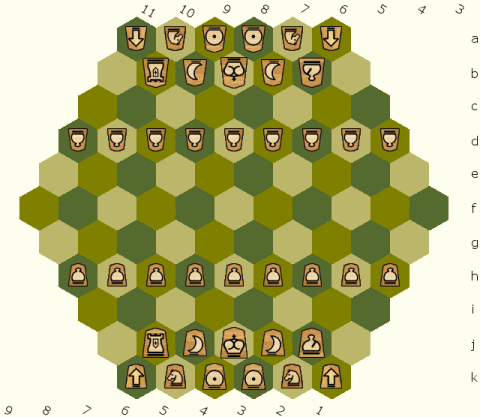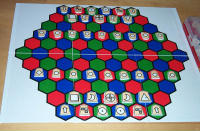Hex Shogi 91
Hex Shogi 91 is a Shogi variant on a hexagonally shaped board of 91 hexagons. This is the same board used for Glinski's Hexagonal Chess and McCooey's Hexagonal Chess, except that it is oriented differently. It is played very much like Shogi, except that pieces are adapted to a hexagonal board, and the restrictions on Pawn drops are different. It is part of the Hex Shogi family of games, invented by Fergus Duniho.
Rules
The object of Hex Shogi 91 is to checkmate your opponent's King. As in Shogi, captured pieces are held in hand by the player who captures them and may be dropped on the board during a later turn. Dropping works just as it does in Shogi with some exceptions. The Shogi rule against dropping a Pawn on a file already occupied by one of your Pawns doesn't work so well for a hexagonal board. So it is left out. The loss of this rule is partially compensated for by not allowing a Pawn to be dropped on a space defended by another Pawn. As further compensation, the rule against checkmating a King with a Pawn drop is replaced with an even stricter rule against checking a King with a Pawn drop. Because the ranks closer to each player are narrower on this board, the promotion area for each player includes four ranks instead of three. A player's piece may promote when it moves through, from, or into any of the first four ranks on the opponent's side of the board. With these exceptions, Hex Shogi 91 plays by the same rules as Shogi. The main difference between these games is in the selection of pieces, the initial setup, the size, shape, and nature of the board, and how pieces move on the two different boards. Initial setup and piece movement are described below.
Setup

Movement
Hex Shogi 91 is played with the same pieces as Shogi, but their movement is adapted to a hexagonal board. The important thing to understanding movement on a hexagonal board is to understand what orthogonal and diagonal mean for a hexagonal board. On a hexagonal board, orthogonal does not mean up, down, left, and right. Instead, spaces are orthogonally adjacent if they share a side in common. The same thing is true for orthogonally adjacent squares. The main difference is that a hexagon's orthogonally adjacent neighbors are not found in all the same directions as a square's orthogonally adjacent neighbors.
Hexagons are diagonally adjacent when they are connected at their corners without sharing any sides in common. This is also true for diagonally adjacent squares. But on a hexagonal board, diagonally adjacent squares do not actually touch at the corners. Instead, they are connected by a side belonging to one or two other hexagons that are orthogonally adjacent to both of them.
The hexagonal board uses three colors, such that orthogonally adjacent squares are never the same color, and diagonally adjacent squares are always the same color. This is the same as it is on the usual board of checkered squares. All diagonal movement is colorbound, and orthogonal movement is never colorbound.
Pieces
| Unpromoted Pieces | Promoted Pieces | ||
|---|---|---|---|
 |
The King can move to any adjacent hexagon, whether orthogonally or diagonally adjacent. This gives it up to 12 spaces it can move to. The King may never move where it can be immediately captured. | The King does not promote. | |
 |
The Rook slides in a straight line across orthogonally adjacent hexagons. It may not jump pieces. On the Hex Shogi 91 board, it may move left, right, left forward, right forward, left backward, and right backward. |  |
The Dragon King is a promoted Rook. It can move one space diagonally or move as a Rook. |
 |
The Bishop slides in a straight line across diagonally adjacent squares. It may not jump pieces. On the Hex Shogi 91 board, it may move up or down in addition to the four directions a Bishop can move in Chess or Shogi. Despite being able to move in directions normally belonging to Rooks, the movement of a Bishop remains colorbound. |  |
A Dragon Horse is a promoted Bishop. It can move one space orthogonally or move as a Bishop. |
 |
The Gold General of Shogi is the Japanese version of the Wazir, which can move one space orthogonally. The Gold General adds to the power of the Wazir the ability to move forward in any direction. Hence, the Gold General of Hex Shogi 91 can move one space in any orthogonal direction or one space in any diagonally forward direction. With a maximum of six orthogonally adjacent hexagons and three more diagonally adjacent hexagons in front of it, a Gold General has up to nine spaces it can move to. | The Gold General does not promote. | |
 |
The Silver General of Shogi is the Japanese version of the Ferz, which can move one space diagonally. The Silver General adds to the power of the Ferz the ability to move forward in any direction. Hence, the Silver General of Hex Shogi 91 can move one space in any diagonal direction or one space in any orthogonally forward direction. With a maximum of six diagonally adjacent hexagons and two more orthogonally adjacent hexagons in front of it, a Silver General has up to eight spaces it can move to. |  |
A promoted Silver General moves just like a Gold General. |
 |
The Lance slides in a straight line orthogonally forward. On the Hex Shogi 91 board, this gives a Lance two directions it can move in. The Lance cannot move backwards. When it moves in the opponent's four rank territory, it may promote to a piece that moves just like a Gold General. Upon reaching the last rank, a Lance must promote. |  |
A promoted Lance moves just like a Gold General. |
 |
Like the Shogi Knight, the Hex Shogi 91 Knight can only move forward. It moves one space orthogonally forward, then one space diagonally outward. Another way to describe its movement is to say that it moves two spaces in the same orthogonally forward direction then turns 60 degrees left or right and moves one more space. Because there are two different orthogonally forward directions, a Knight can cover up to four different spaces. When it moves in the opponent's four rank territory, it may promote to a piece that moves just like a Gold General. Upon reaching one of the last two ranks, a Knight must promote. |  |
A promoted Knight moves just like a Gold General. |
 |
A Pawn moves and captures one space orthogonally forward. On the Hex Shogi 91 board, this gives it two different spaces it can move to, which allows Pawns to occupy a common file. Because of this, the rule from Shogi against dropping a Pawn on a file already occupied by a friendly Pawn is left out. When a Pawn moves in the opponent's four rank territory, it may promote to a Tokin, which moves as a Gold General. Upon reaching the last rank, a Pawn must promote. |  |
A Tokin is a promoted Pawn. It moves just like a Gold General. |
Equipment

|
I have made my own set, shown in the photograph here, and the following pages describe how you can make your own set like it. |